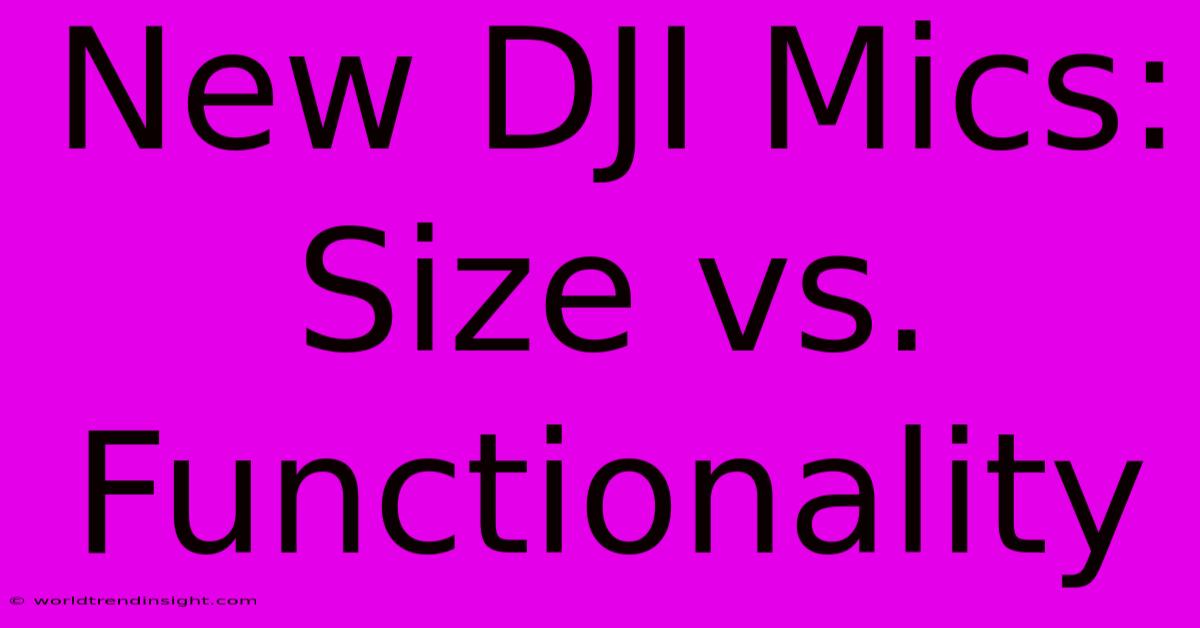New DJI Mics: Size Vs. Functionality

Discover more detailed and exciting information on our website. Click the link below to start your adventure: Visit Best Website New DJI Mics: Size Vs. Functionality. Don't miss out!
Table of Contents
New DJI Mics: Size vs. Functionality – A Balancing Act
Hey everyone! So, I've been obsessed with DJI's new microphone releases. Seriously, I've spent way too much time watching reviews and comparing specs. It's like choosing between a fancy sports car and a reliable pickup truck – both have their pros and cons! This post is all about my own personal journey figuring out which DJI mic is right for me (and maybe, just maybe, it'll help you too!).
My Epic Mic Fail (and What I Learned)
Let me tell you a story. I'm working on a documentary about urban farming, right? I'm thinking, "I need killer audio. Crystal clear. No background noise." So, I splurged. I bought the biggest DJI mic they had – thinking bigger = better. Wrong. So, so wrong.
The thing was HUGE. Seriously, it was like strapping a small, metal alien to my camera. It was cumbersome, constantly getting in the way. Plus, the sheer weight made my gimbal complain. I’m sure my camerawork suffered, too. It was a nightmare. My interviews looked like they were filmed by a newborn giraffe. I ended up using my old, smaller lavalier mic instead!
Lesson Learned #1: Size Matters (But Not Too Much!)
That experience taught me a valuable lesson: size and functionality need to be balanced. While bigger mics can offer superior sound quality, you gotta consider the practicality of shooting. A bulky microphone can heavily impact your maneuverability, especially when working in tight spaces. What good is amazing audio if your footage is shaky and awkward?
DJI Mic vs. DJI Mic 2: A Tale of Two Sizes
Now, let's talk specifics. DJI's released a few different microphones, but the DJI Mic and the DJI Mic 2 are the big players in this size versus functionality debate. The original DJI Mic is relatively compact – relatively being the key word. It's still bigger than a lot of lavalier mics but offers great quality for the size.
The DJI Mic 2, however, is smaller, way sleeker, and more convenient to carry around. It’s basically the compact version; super cool. It also boasts improved features like a built-in LCD screen showing the battery life and input levels, which is a major win for me. But there's a trade-off. Sound quality-wise, they are both very good, but some reviewers found the DJI Mic (the original, larger one) to have a slight edge in certain situations. A tiny edge, but an edge none-the-less.
Lesson Learned #2: Check the Specs (Seriously!)
Don't just look at the pictures! Dive deep into the tech specs. Pay attention to things like frequency response, signal-to-noise ratio, and the maximum recording distance. These numbers tell you a lot about how well the mic will handle different recording environments. I didn't do this the first time, and it cost me time and frustration.
What's Right For You?
So, which DJI mic should you choose? It depends on your priorities. If you need the absolute best possible sound quality, and bulk isn’t a concern – the original DJI Mic might be worth considering. But if you value portability, ease of use, and a more discreet setup, the DJI Mic 2 is a total winner.
Honestly, I ended up getting both. I use the DJI Mic 2 for on-the-go stuff, and the larger DJI Mic when I'm in a controlled environment and want that extra bit of quality. Both are good options, just depends on your workflow.
Remember, the best microphone is the one you’ll actually use! Don't get caught up in chasing the perfect piece of gear; focus on finding the right tool for the job. And always, always, always read reviews! Good luck with your filmmaking adventures.

Thank you for visiting our website wich cover about New DJI Mics: Size Vs. Functionality. We hope the information provided has been useful to you. Feel free to contact us if you have any questions or need further assistance. See you next time and dont miss to bookmark.
Featured Posts
-
Uk Bank Holiday 2025 Update
Nov 27, 2024
-
13 Year Old Ipl Player Faces Age
Nov 27, 2024
-
Memecoin Boost Ton Funds Hot Labs
Nov 27, 2024
-
Milans Starting Xi Vs Slovan
Nov 27, 2024
-
Arsenals 5 0 Win Over Sporting
Nov 27, 2024
